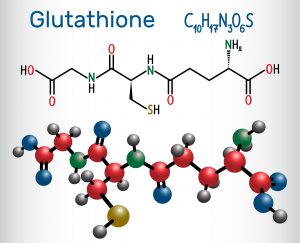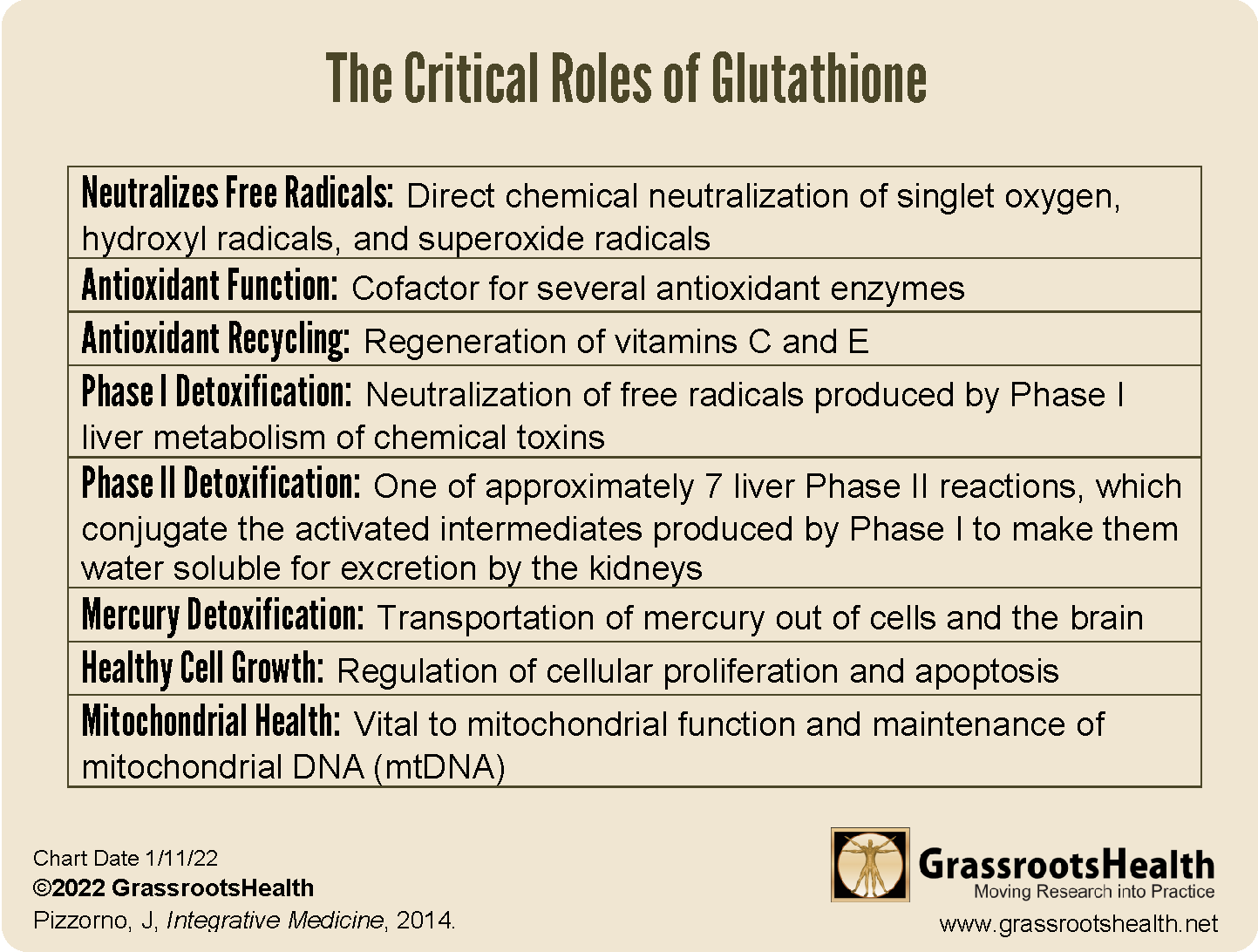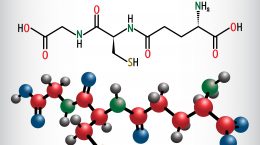Published on September 2, 2022
Vitamin D level may affect levels of the “Master Antioxidant” glutathione, known to help maintain health, protect from toxins, and promote longevity
Key Points
- Glutathione is critical to help protect our cells from damage due to oxidative stress, mercury and other toxic metals, alcohol, persistent organic pollutants; it also protects the mitochondria and is vital to energy production
- Research over the last several years has illustrated a positive relationship between glutathione and vitamin D, with higher vitamin D levels related to higher glutathione levels. Additional research has demonstrated that correcting vitamin D deficiency can, in itself, increase glutathione levels.
- Learn how to keep glutathione levels up with additional tips while also avoiding vitamin D deficiency
 Many consider glutathione to be the “Master Antioxidant.” It is the most abundant antioxidant in the body and it helps recycle other antioxidants, such as vitamins C and E. Glutathione is necessary to help protect our cells from damage due to oxidative stress, mercury and other toxic metals, alcohol, persistent organic pollutants, and much more. It also helps protect our mitochondria and is vital to energy production.
Many consider glutathione to be the “Master Antioxidant.” It is the most abundant antioxidant in the body and it helps recycle other antioxidants, such as vitamins C and E. Glutathione is necessary to help protect our cells from damage due to oxidative stress, mercury and other toxic metals, alcohol, persistent organic pollutants, and much more. It also helps protect our mitochondria and is vital to energy production.
In fact, levels of glutathione within the cells and mitochondria are highly associated with health and longevity, and its deficiency is associated with many chronic diseases and loss of function with aging.
What is Glutathione and Why it is Important
The following video, Glutathione: the most powerful antioxidant in your body, provides an excellent overview of this important molecule and how it works to combat oxidative stress and its related diseases, as well as aging.
In summary,
- Glutathione helps to repair or counteract the breakage and unraveling of cells that free radicals and oxidants tend to cause
- For instance, glutathione repairs the “caps” (known as telomeres) that are found at the end of chromosomes. If that cap is broken, DNA can unravel!
- Its role in the repairing of nerve and cell damage caused by free radicals explains why it’s also referred to as the “master” antioxidant
- It is difficult to maintain healthy levels of glutathione through supplements, as it is mainly produced in the body
- The production of glutathione decreases with age; when people reach 40, they produce around 30% less glutathione, and by age 65, that reduction can reach 50%
Glutathione is made of 3 different amino acids: cysteine, glycine, and glutamic acid. It is found in two different forms; reduced glutathione (GSH) is the “active” form that is able to repair oxidative damage, and oxidized glutathione (GSSG) is the inactive form that can be recycled back into GSH.
The following table by Pizzorno, J. highlights the critical roles of glutathione.
Increasing Vitamin D Could Help Increase Glutathione, and Vice Versa
Research over the last several years has illustrated a positive relationship between glutathione and vitamin D, with higher vitamin D levels related to higher glutathione levels. Additional research has demonstrated that correcting vitamin D deficiency can, in itself, increase glutathione levels. One such study found that glutathione levels increased when vitamin D deficiency was corrected among children with nutritional rickets.
A 2018 study by Jain et al. suggests that increasing glutathione status can improve the bioavailability of vitamin D and can more effectively correct vitamin D deficiency than vitamin D supplementation alone. The publication concluded that “Supplementation with a combination of vitamin D and L-cysteine or glutathione precursor, rather than supplementation with vitamin D alone, is beneficial and helps achieve more successful vitamin D supplementation.”
Study Confirms Significant Effect of Vitamin D Level on Levels of Glutathione, GSSG, and Cysteine
A study by Alvarez et al. looked at the bloodwork from 693 healthy adults which measured their vitamin D levels, plasma glutathione, cysteine (a glutathione precursor), and multiple inflammatory markers to see what relationships existed. They found that vitamin D levels [25(OH)D] were positively associated with plasma glutathione (as vitamin D levels increased so did glutathione) and negatively associated with both GSSG and cysteine (as vitamin D levels increased, levels of GSSG and cysteine decreased). These associations remained statistically significant even after adjusting for other factors.
Other Ways to Increase Intracellular Glutathione Levels
Correcting vitamin D deficiency is important for many aspects of health and for the health of each system of the body, and as discussed here, it has been shown to be important for maintaining higher levels of glutathione. Low levels of glutathione are also associated with chronic exposure to chemical toxins and alcohol, cadmium exposure, smoking, AIDS/HIV, macular degeneration, Parkinson’s disease, and other neurodegenerative disorders.
Here are some other ways to help increase levels of glutathione, along with taking care to optimize vitamin D:
- limit alcohol consumption
- decrease exposure to POPs
- increase intake of other antioxidants to decrease overall oxidative stress
- increase intake of nutrients that promote glutathione production, such as NAC (N-acetylcysteine), 1000 mg/day, whey, or SAMe
- get enough magnesium and selenium in the diet, as both are necessary for glutathione production
- foods such as almonds, cruciferous vegetables, and even alcohol-free beer have been shown to raise glutathione levels, as has exercise and meditation!
Measure Your Vitamin D Level, Along with Essential Minerals and Toxic Elements that can affect Glutathione Production
 Having and maintaining healthy vitamin D levels and other nutrient levels can help improve your health now and for your future. For healthy glutathione levels, consider measuring vitamin D along with
Having and maintaining healthy vitamin D levels and other nutrient levels can help improve your health now and for your future. For healthy glutathione levels, consider measuring vitamin D along with
- Magnesium PLUS Elements (highly recommended)
- Omega-3 Index with Ratios
- hsCRP (a measure of inflammation)
by creating your custom home test kit today. Take steps to improve the status of each of these measurements to benefit your overall health. You can also track your own intakes, symptoms and results to see what works best for YOU.
Enroll and test your levels today, learn what steps to take to improve your status of vitamin D (see below) and other nutrients and blood markers, and take action! By enrolling in the GrassrootsHealth projects, you are not only contributing valuable information to everyone, you are also gaining knowledge about how you could improve your own health through measuring and tracking your nutrient status, and educating yourself on how to improve it.


 Click to Enlarge & Print
Click to Enlarge & Print


